
The American Quarter Horse, or Quarter Horse, is an American breed of horse that excels at sprinting short distances. Its name is derived from its ability to outrun other horse breeds in races of 1⁄4 mi (0.40 km) or less; some have been clocked at speeds up to 44 mph (71 km/h). The development of the Quarter Horse traces to the 1600s.

Roan is a coat color found in many animals, including horses, cattle, antelope, cat and dogs. It is defined generally as an even mixture of white and pigmented hairs that do not "gray out" or fade as the animal ages. There are a variety of genetic conditions which produce the colors described as "roan" in various species.

Palomino is a genetic color in horses, consisting of a gold coat and white mane and tail; the degree of whiteness can vary from bright white to yellow. The palomino color derived from the inter-breeding of Spanish horses with those from the United States. Genetically, the palomino color is created by a single allele of a dilution gene called the cream gene working on a "red" (chestnut) base coat. Palomino is created by a genetic mechanism of incomplete dominance, hence it is not considered true-breeding. However, most color breed registries that record palomino horses were founded before equine coat color genetics were understood as well as they are today, therefore the standard definition of a palomino is based on the visible coat color, not heritability nor the underlying presence of the dilution gene.

The Arabian or Arab horse is a breed of horse with historic roots on the Arabian Peninsula. With a distinctive head shape and high tail carriage, the Arabian is one of the most easily recognizable horse breeds in the world. It is also one of the oldest modern breeds. Although modern DNA cannot trace breed purity in the modern population beyond 200 years, there is archaeological evidence of horses in the Middle East with landrace characteristics that resemble modern Arabians dating back 3,500 years. Throughout history, Arabian horses have spread around the world by both war and trade, used to improve other breeds by adding speed, refinement, endurance, and strong bone. Today, Arabian bloodlines are found in almost every modern breed of riding horse.

The American Paint Horse is a breed of horse that combines both the conformational characteristics of a western stock horse with a pinto spotting pattern of white and dark coat colors. Developed from a base of spotted horses with Quarter Horse and Thoroughbred bloodlines, the American Paint Horse Association (APHA) breed registry is now one of the largest in North America. The registry allows some non-spotted animals to be registered as "Solid Paint Bred" and considers the American Paint Horse to be a horse breed with distinct characteristics, not merely a color breed.

Lethal white syndrome (LWS), also called overo lethal white syndrome (OLWS), lethal white overo (LWO), and overo lethal white foal syndrome (OLWFS), is an autosomal genetic disorder most prevalent in the American Paint Horse. Affected foals are born after the full 11-month gestation and externally appear normal, though they have all-white or nearly all-white coats and blue eyes. However, internally, these foals have a nonfunctioning colon. Within a few hours, signs of colic appear; affected foals die within a few days. Because the death is often painful, such foals are often humanely euthanized once identified. The disease is particularly devastating because foals are born seemingly healthy after being carried to full term.
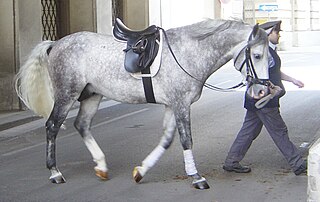
A gray horse has a coat color characterized by progressive depigmentation of the colored hairs of the coat. Most gray horses have black skin and dark eyes; unlike some equine dilution genes and some other genes that lead to depigmentation, gray does not affect skin or eye color. Gray horses may be born any base color, depending on other color genes present. White hairs begin to appear at or shortly after birth and become progressively more prevalent as the horse ages as white hairs become intermingled with hairs of other colors. Graying can occur at different rates—very quickly on one horse and very slowly on another. As adults, most gray horses eventually become completely white, though some retain intermixed light and dark hairs.

The cream gene is responsible for a number of horse coat colors. Horses that have the cream gene in addition to a base coat color that is chestnut will become palomino if they are heterozygous, having one copy of the cream gene, or cremello, if they are homozygous. Similarly, horses with a bay base coat and the cream gene will be buckskin or perlino. A black base coat with the cream gene becomes the not-always-recognized smoky black or a smoky cream. Cream horses, even those with blue eyes, are not white horses. Dilution coloring is also not related to any of the white spotting patterns.
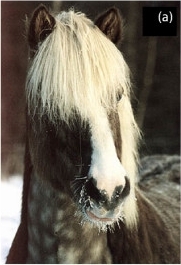
The silver or silver dapple (Z) gene is a dilution gene that affects the black base coat color and is associated with Multiple Congenital Ocular Abnormalities. It will typically dilute a black mane and tail to a silvery gray or flaxen color, and a black body to a chocolaty brown, sometimes with dapples. It is responsible for a group of coat colors in horses called "silver dapple" in the west, or "taffy" in Australia. The most common colors in this category are black silver and bay silver, referring to the respective underlying coat color.

Equine coat color genetics determine a horse's coat color. Many colors are possible, but all variations are produced by changes in only a few genes. Bay is the most common color of horse, followed by black and chestnut. A change at the agouti locus is capable of turning bay to black, while a mutation at the extension locus can turn bay or black to chestnut.
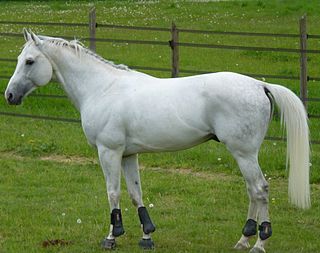
The Anglo-Arabian, also known as the Anglo-Arab, is a horse breed that originated in France by cross-breeding a Thoroughbred with an Arabian. The Anglo-Arabian has origins tracing back to the Limousin Horse. It was officially recognized by Emperor Louis Philippe I and produced by the Haras National du Pin. The Anglo-Arabian has long legs, a refined head, larger hindquarters, and are most commonly seen in gray, bay, or chestnut. To be recognized as an Anglo-Arabian with the Arabian Horse Association, the horse must have at least 25% Arabian blood. There are no color or height restrictions to be registered. Due to its lineage and physique, the Anglo-Arabian is utilized for sports-related activities such as dressage, show jumping, endurance, and cross-country.

A pinto horse has a coat color that consists of large patches of white and any other color. Pinto coloration is also called paint, particolored, or in nations that use British English, simply coloured. Pinto horses have been around since shortly after the domestication of the horse.
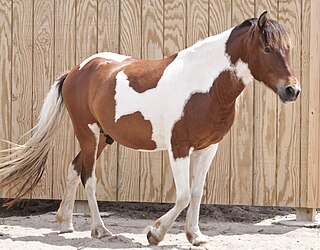
Tobiano is a spotted color pattern commonly seen in pinto horses, produced by a dominant gene. The tobiano gene produces white-haired, pink-skinned patches on a base coat color. The coloration is almost always present from birth and does not change throughout the horse's lifetime, unless the horse also carries the gray gene. It is a dominant gene, so any tobiano horse must have at least one parent who carries the tobiano gene.
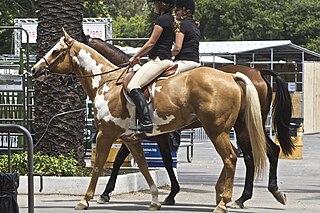
Overo refers to several genetically unrelated pinto coloration patterns of white-over-dark body markings in horses, and is a term used by the American Paint Horse Association to classify a set of pinto patterns that are not tobiano. Overo is a Spanish word, originally meaning "like an egg". The most common usage refers to frame overo, but splashed white and sabino are also considered "overo". A horse with both tobiano and overo patterns is called tovero.

Horses exhibit a diverse array of coat colors and distinctive markings. A specialized vocabulary has evolved to describe them.

Cerebellar abiotrophy (CA), also called cerebellar cortical abiotrophy (CCA), is a genetic neurological disease in animals, best known to affect certain breeds of horses, dogs and cats. It can also develop in humans. It develops when the neurons known as Purkinje cells, located in the cerebellum of the brain, begin to die off. These cells affect balance and coordination. They have a critical role to play in the brain. The Purkinje layer allows communication between the granular and molecular cortical layers in the cerebellum. Put simply, without Purkinje cells, an animal loses its sense of space and distance, making balance and coordination difficult. People with damage to the cerebellum can experience symptoms like unsteady gait, poor muscle control, and trouble speaking or swallowing.

A white horse is born predominantly white and stays white throughout its life. A white horse has mostly pink skin under its hair coat, and may have brown, blue, or hazel eyes. "True white" horses, especially those that carry one of the dominant white (W) genes, are rare. Most horses that are commonly referred to as "white" are actually "gray" horses whose hair coats are completely white. Gray horses may be born of any color and their hairs gradually turn white as time goes by and take on a white appearance. Nearly all gray horses have dark skin, except under any white markings present at birth. Skin color is the most common method for an observer to distinguish between mature white and gray horses.
The severe combined immunodeficiency (SCID) is a severe immunodeficiency genetic disorder that is characterized by the complete inability of the adaptive immune system to mount, coordinate, and sustain an appropriate immune response, usually due to absent or atypical T and B lymphocytes. In humans, SCID is colloquially known as "bubble boy" disease, as victims may require complete clinical isolation to prevent lethal infection from environmental microbes.

Roan is a horse coat color pattern characterized by an even mixture of colored and white hairs on the body, while the head and "points"—lower legs, mane, and tail—are mostly solid-colored. Horses with roan coats have white hairs evenly intermingled throughout any other color. The head, legs, mane, and tail have fewer scattered white hairs or none at all. The roan pattern is dominantly inherited, and is found in many horse breeds. While the specific mutation responsible for roan has not been exactly identified, a DNA test can determine zygosity for roan in several breeds. True roan is always present at birth, though it may be hard to see until after the foal coat sheds out. The coat may lighten or darken from winter to summer, but unlike the gray coat color, which also begins with intermixed white and colored hairs, roans do not become progressively lighter in color as they age. The silvering effect of mixed white and colored hairs can create coats that look bluish or pinkish.

Ann Trommershausen Bowling was an American scientist who was one of the world's leading geneticists in the study of horses, conducting research in the areas of molecular genetics and cytogenetics. She was a major figure in the development of testing to determine animal parentage, first with blood typing in the 1980s and then DNA testing in the 1990s. She later became known for her studies of hereditary diseases in horses and equine coat color genetics, as well as research on horse evolution and the development of horse breeds. She studied the population genetics of feral horses, did considerable work to help preserve the Przewalski's horse, and was one of the founding members of the international project to map the horse genome. She was an adjunct professor at the University of California, Davis (UCD), and at the time of her death in 2000 was the executive associate director of the Veterinary Genetics Laboratory (VGL) there. Her unexpected death on December 8, 2000, at age 57 was attributed to a massive stroke.



















